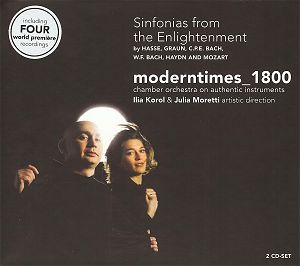 |
 |
|


alternatively
CD: AmazonUK
AmazonUS
Download: Classicsonline
|
Sinfonias from the Enlightenment
CD 1
Johann Adolf HASSE (1699 - 1783)
Sinfonia in D (Overture to Alcide al bivio) [07:56]
Johann Gottlieb GRAUN (1702 - 1771)
Sinfonia in E flat [07:05]
Carl Philipp Emanuel BACH (1714
- 1788)
Sinfonia in B flat (H deest / Wq deest) [11:19]
Wilhelm Friedemann BACH (1710 -
1784)
Sinfonia in D (from Cantata Dies ist der Tag) (F 64 / BR WFB
C 8) [09:59]
Carl Philipp Emanuel BACH
Sinfonia in E flat (H deest / Wq deest) [09:14]
CD 2
Franz Joseph HAYDN (1732 - 1809)
Symphony in g minor (H I,39) [18:14]
Wolfgang Amadeus MOZART (1756 -
1791)
Symphony No 29 in a minor (KV 201) [29:21]
 Moderntimes 1800/Ilia Korol, Julia Moretti
Moderntimes 1800/Ilia Korol, Julia Moretti
rec. 28 September - 2 October 2007, Congress & Messe, Innsbruck,
Austria DDD
 CHALLENGE RECORDS CC72193 [45:37 + 47:37]
CHALLENGE RECORDS CC72193 [45:37 + 47:37] 
|
|
|
The music on these two discs was written within
the period roughly between 1740 and 1775. It is not easy to put
a label on the music of this era. The title refers to the Enlightenment
but that doesn't really help to define the style of composition.
Several terms are employed to describe the music between the baroque and the classical era. Sturm und Drang and Empfindsamkeit are often used, but there is also music written in the galant idiom. Part of the problem is that these styles appear at the same time, sometimes even within a single composition. The various styles partly reflect the preferences of the composers, but also the target group. Music for amateurs - mostly chamber music, especially for or with flute - was often of a galant nature.
The compositions recorded on these discs were written for professional ensembles, and show considerably more depth than the music for amateurs. But there was no watershed between the two, as is evident from the symphonies by Carl Philipp Emanuel Bach. Veronika Zimmermann, in her programme notes, states that their slow movements show traces of the galant idiom, whereas the fast movements reflect the Sturm und Drang. She also mentions that the music in this period often contains passages in the 'old-fashioned' style of the baroque era, with its use of counterpoint. The oeuvre of Wilhelm Friedemann Bach is an excellent example of music with a mixture of tradition and modern fashion.
There is one feature which the Empfindsamkeit and the Sturm und Drang have in common: the crucial role of emotion. Baroque music was not without emotion, but it was very much regulated. The baroque composer had a number of tools at his disposal - keys, instruments and rhetorical figures - to express emotion. These were not necessarily his personal emotions, and performers were not supposed to show their personal feelings while singing or playing. That changes in the post-baroque era. Carl Philipp Emanuel Bach specifically expected performers to feel the emotions which the music was intended to express. We know from descriptions that he showed his own emotions in abundance when he played the keyboard.
The emotional style of the mid-18th century expresses itself in sudden changes of dynamic, a quick shift of thematic material and unexpected general pauses. It is telling that all the symphonies by Carl Philipp Emanuel Bach, Graun and Hasse on the programme have a slow movement whose character indications contain the words 'con sordino'.
The scoring of the various orchestral works shows that the orchestra had considerably changed since the baroque era. The baroque 'orchestra' mostly consisted of strings and bc, with now and then one or a couple of wind instruments. In all symphonies on the first disc the orchestra includes woodwind and brass, mostly in pairs. The treatment of the wind is various. In Graun's Sinfonia in E flat the flutes only participate in the last movement in which they largely play colla parte with the violins. In the andante of Wilhelm Friedemann Bach's Sinfonia in D the flutes play a solo role. In Carl Philipp Emanuel Bach's Sinfonia in E flat the bassoons have a marked role in the larghetto con sordino, whereas in the closing allegretto the horns come especially to the fore. In the Sinfonia in D by Johann Adolf Hasse the two fast movements are quite exuberant, mainly because of prominent parts for the brass.
The second disc contains two symphonies by composers who are considered representatives of the classical era. But the Symphony No. 39 by Haydn which dates from before 1770, contains some features of the Sturm und Drang. In particular in the first two movements we find the general pauses and sudden dynamic outbursts which are features of that style. Mozart's symphony has little of this. Through its inclusion this set shows how the generation of the sons of Bach paved the way for the classical style.
The performances are generally very good. The wind parts are clearly exposed, and that isn't just because they are played well but also because the balance between the various sections of the ensemble is good. The sound of the orchestra is crisp and clear, and the dynamic contrasts are well realised. Mozart's symphony No. 29 is by far the best-known work of the set, and there is much competition. Although the performance is good I wouldn't purchase this set because of this symphony. The crescendos in the first movement are beautifully played, the andante is alright, but the menuetto is a bit too slow, and so is the allegro con spirito. Here I also find the dynamic range too narrow.
This production delivers a good and interesting survey of the development of orchestral music during an important stage in music history. The first disc is especially important as it contains four first recordings.
Johan van Veen
|
|

